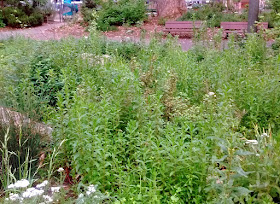This picture was taken on a very rainy day just about two years ago. It's a great reminder of the beginnings of our rain garden, located in the Panhandle next to the children's playground.
The garden has been hugely helped by the abundant seasonal rains this year. A large number of volunteers have also worked to keep weeds at bay - and they've been largely successful. While there are several kinds of weedy grasses in the garden, they are just a small portion on the vegetation, and they are outmatched by several species of native grass, including Nasella pulchra (Purple needlegrass).
The red-stem dogwoods have grown quickly, and this spring after putting out leaves they are now beginning to display their small white flowers. Many species of birds visit the protective thicket.
The yarrow forms a solid border on the north side of the garden, and is setting up for a long bloom in late spring/early summer.
Meanwhile on the opposite side, a more delicate plant called Potentilla gracilis (Graceful cinquefoil) is prolific. Its bright yellow flowers bloom in summer-fall. These three plants - the dogwood, yarrow, and cinquefoil - are some of the plants in the garden that, in the future, we may choose to cut back, in order to increase the diversity within the rain garden. Pruning back native plants takes effort, but it's a great situation for this project to be in.
The willowherb - growing profusely on the side of the garden near the basketball courts - may call for slightly different measures. We have discussed the willowherb at workdays and have puzzled over whether to remove it. We did not plant it; even the exact species is elusive ... I guess it is Epilobium parviflorum or ciliatum or hirsutum...so maybe it's native, maybe not. There will be a summer bloom of thousands of tiny bright purple-pink flowers. I leaned toward leaving them in place, preferring them to more intrusive grasses that wash into the garden with each rainfall. By mid summer, though, many of them may need to go. After blooming, their seeds quickly emerge, attached to long white fibers and hanging on to the tops of the plants a bit like spiderwebs..and then the whole plant dies. It might be a good idea to remove some of them this summer, both for appearance and to keep it from extending its reach around the garden.






